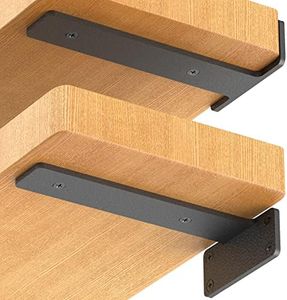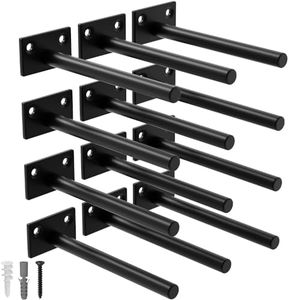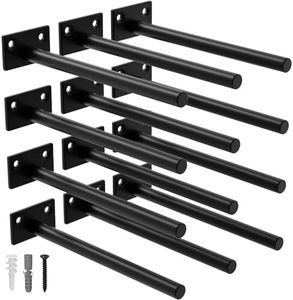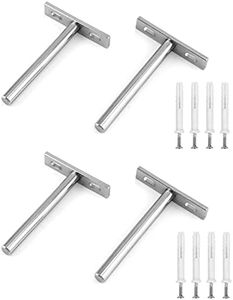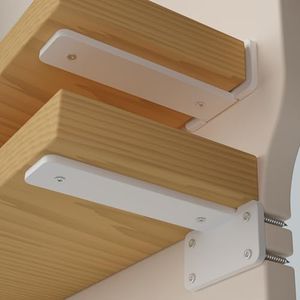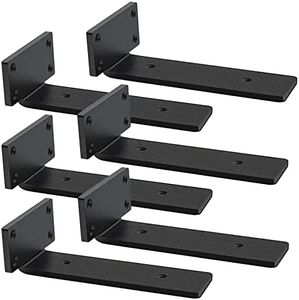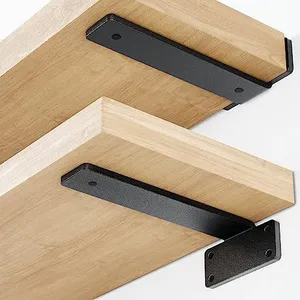We Use CookiesWe use cookies to enhance the security, performance,
functionality and for analytical and promotional activities. By continuing to browse this site you
are agreeing to our privacy policy
10 Best Floating Shelf Brackets
From leading brands and best sellers available on the web.By clicking on a link to a third party's website, log data is shared with that third party.
Buying Guide for the Best Floating Shelf Brackets
Choosing floating shelf brackets can seem like a small decision, but it has a big impact on the appearance, strength, and longevity of your shelves. The right brackets will keep your shelf level, secure, and capable of holding the items you want to display. It's important to consider both the look and the function, as shelf brackets come in different types and with various features. Start by imagining what you want your finished shelf to look like, and think about what you plan to put on it. Also, pay attention to the surface you'll be attaching your brackets to, such as drywall, concrete, or wood. This will help guide your choice to the best fit for your need.Weight CapacityWeight capacity tells you how much weight the floating shelf bracket can support. This is extremely important because overloading a shelf can lead to accidents or damage to your wall. Brackets typically come rated for light (up to about 15-20 lbs), medium (20-50 lbs), and heavy (over 50 lbs) loads per pair. If you’re only planning to display decor items or photos, light-duty brackets are usually enough. For books, small appliances, or heavier displays, look for medium- to heavy-duty brackets. Matching your needs to the right capacity ensures safety and durability.
Bracket Size and Arm LengthBracket size and arm length determine how far your shelf will project from the wall and how stable it will be. Short arms (about 4-6 inches) suit shallow shelves for light items, while longer arms (8-12 inches or more) are needed for deeper, heavier shelves. The rule of thumb is that the arm should support at least two-thirds of the shelf’s depth, so always choose based on your shelf’s actual size and intended use. Picking the right arm length keeps your shelf from tilting or sagging.
Installation MethodThe installation method refers to how the bracket attaches to the wall and how the shelf attaches to the bracket—typically by screws, anchors, or mounting plates. Some brackets are designed for specific wall types (e.g., drywall vs. masonry). It’s important to check that the installation method matches your wall surface and skill level. If you’re unsure, look for brackets labeled as 'easy installation,' or consult with a hardware expert. A proper installation is key for safety and stability.
Material and FinishShelf brackets are commonly made from metals (steel, aluminum) or strong plastics, with finishes such as powder coating, chrome, or paint. The material and finish affect both the strength and the appearance. Metal brackets are typically stronger and offer a more industrial or modern look, while plastics are lighter and may be suitable for light shelves in low-traffic areas. Choose a material and finish that matches your shelf board and room decor. Consider where the shelf is going—is it in a kitchen, bathroom, or living space? Each environment might benefit from a different finish for style and resistance to moisture or wear.
Concealment and AestheticsFloating shelf brackets are designed to be hidden from sight, giving shelves a clean, 'floating' look. Some brackets are completely concealed when installed, while others leave a small part visible. Think about whether you want a totally invisible mounting, or if some decorative element is acceptable or even desirable. Your decision here should be guided by your design preference and how prominent you want the shelf to be as a feature in your room.
